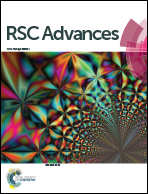Effective conversion of biomass-derived ethyl levulinate into γ-valerolactone over commercial zeolite supported Pt catalysts†
Abstract
The synthesis of γ-valerolactone from biomass-derived ethyl levulinate is of great importance for biomass conversion. However, development of efficient catalytic systems which are simple, commercially available, easy for preparation, and large-scale for the hydrogenation of ethyl levulinate to afford γ-valerolactone is still necessary. Here, a series of commercial zeolite supported catalysts were synthesized by using a wet impregnation method for the systemic investigation of the hydrogenation of biomass-derived ethyl levulinate. High yield and selectivity towards GVL were achieved and varied and systematic characterizations including XRD, XPS, TEM and BET were used to investigate these catalysts. The influence of different reaction condition parameters was also investigated and discussed. The construction of zeolite supported catalysts showed broad prospects for the conversion of biomass into biofuels.


 Please wait while we load your content...
Please wait while we load your content...